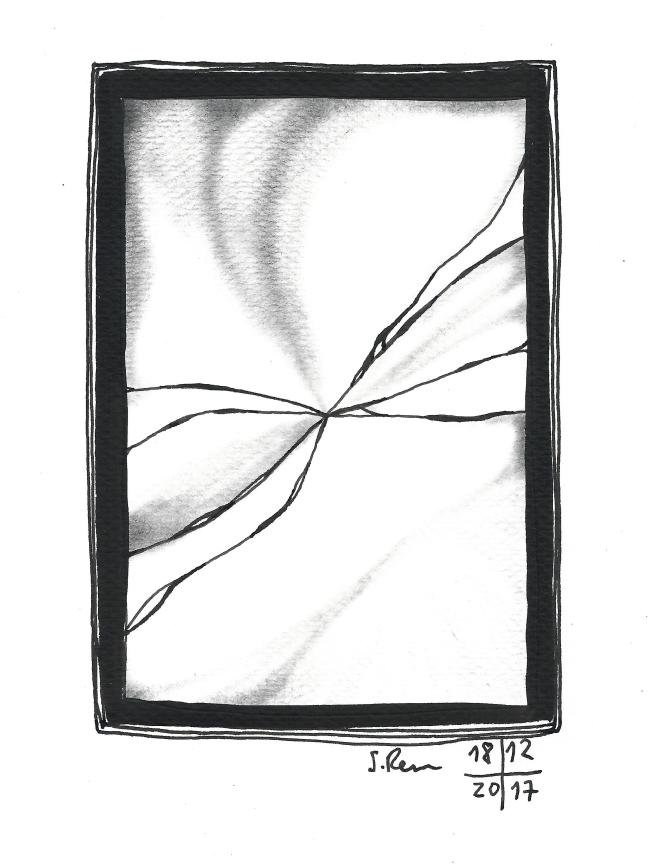
(This is a post that has previously appeared here, however now with four illustrations by Susanne Rempt).
All mirrors are inherently mysterious and magical. The moment when Narcissus looked into the lake and realised that what he saw reflected was at one and the same time the self and an image was the moment of a great divide, a second Fall, but as certain Gnostic sects argued about the temptation of Eve and the expulsion from the Garden of Eden this recognition was a necessary loss of Innocence. It was the first experience of a mediated reality. All that was needed was the technical expertise to manufacture mirrors to disseminate this heightened self-awareness to every individual. And from mirrors it was only a matter of time before the camera and then film which led to the media landscape that envelops and dominates our perception today.
Mirrors are mentioned frequently in myth, folk-lore and religion; not to mention in art and literature. In Corinthians Paul says of our knowledge of the divine ‘For now we see through a glass, darkly; but then face to face: now I know in part; but then shall I know even as also I am known’. In Vodou, the syncretic religion practised widely in Haiti that combines elements of West African spirit religion, Catholicism and arguably Mesoamerican traditions, the altars of hounfours (temples)
are decorated with mirrors as they are conduits that the houngan use to contact the spirit world. Many cultures at many times held the tradition of covering all mirrors in the house when in mourning, this custom persists today in Judaism. In connection with a heresy held by one of the numerous Gnostic sects Borges states ‘Mirrors and copulation are abominable, since they both multiply the numbers of men.’
In libertine fiction mirrors play a large part as they increase the pleasure of the moment and enables the libertine to view the erotic scene which they are actively participating in. In the sparkling sophisticated jewel of a tale Point de lendemain (No Tomorrow) by Vivant Denon the artful heroine describes to her paramour the delights of her chamber with its reflective glass covering every wall, when he enters he is enchanted to find a ‘a vast cage of mirrors’ and then states that, ‘Desires are reproduced through their image’.
One of the most memorable mentions in fairy-tales of the deceptive nature of the looking-glass is the Magic Mirror of the Evil Queen in Snow White, which is a good illustration of William Blake’s quote ‘A truth told with evil intent beats any lie you could invent.’
However, for me the supreme moment for the mirror in literature is when Alice steps through to the other side of the looking glass.  Ever since the phrase has been used to describe many different and varying experiences; the transfigured absolute reality glimpsed in insanity; the shifting contours of the nightly dreamscape, the heavens and hells of drug use (the John Tenniel illustration was reproduced on LSD blotters in the sixties) the transcendence achieved in sexual ecstasy, and ultimately death, that unknowing inevitable frontier where we hope that the outward appearance will vanish to be replaced for all eternity by our fundamental essence. For although mirrors are just surface and can deceive, distort and warp, they also always reveal something other than just ourselves.
Ever since the phrase has been used to describe many different and varying experiences; the transfigured absolute reality glimpsed in insanity; the shifting contours of the nightly dreamscape, the heavens and hells of drug use (the John Tenniel illustration was reproduced on LSD blotters in the sixties) the transcendence achieved in sexual ecstasy, and ultimately death, that unknowing inevitable frontier where we hope that the outward appearance will vanish to be replaced for all eternity by our fundamental essence. For although mirrors are just surface and can deceive, distort and warp, they also always reveal something other than just ourselves.

Looking good… Thank you, as always for the inspiration.
LikeLiked by 4 people
My pleasure, thank you for your excellent interpretations.
LikeLiked by 2 people
Yeah there’s an art piece I have in my sketchbook. Maybe it’s time to get that out.
LikeLiked by 1 person
Maybe it is time.
LikeLiked by 1 person
All my pleasure!
LikeLiked by 2 people
Wonderful and interesting post. The illustrations are marvelous. I read Alice again recently. Always a new detail to ponder.
LikeLiked by 3 people
Thank you the illustrations are wonderful. What more can I say about Alice? Step this way to the Looking Glass World…
LikeLiked by 2 people
Well, everything looks more interesting in reverse, I say.
LikeLiked by 3 people
Maybe we are already on the other side and when we look in the mirror that is reality.
LikeLiked by 2 people
And no way to verify. How very disconcerting.
LikeLiked by 2 people
Well the world is quite disconcerting so I maybe onto something.
LikeLiked by 2 people
I love using mirrors around the place, they are so other worldly. I totally agree with you that it would be pretty hard to beat the literary impact of Alice entering the other side of the mirror and Tenniel’s paired drawings of her on the mantelpiece are unforgettable.
I live in a solar powered house so I have positioned mirrors to reflect the night lights. I like to put old mirrors on the sheds and through the garden to give beautiful images of the trees and ochre clays and bright blue skies as I wander past them.
LikeLiked by 2 people
Ah your house sounds heavenly. Glad you liked the post and thank you as always for your wonderfully entertaining comments. I am very partial to the Alice books which I constantly reference.
LikeLiked by 1 person
This is terrific post! You two are awesome. ❤
LikeLiked by 2 people
Thank you Kindra…I am slowly getting back in the groove. Happy New Year, I am glad you enjoyed my rambling thoughts and the illustrations.
LikeLiked by 1 person
Happy New Year, Mr. Cake!
LikeLiked by 2 people
Fascinating stuff! The endless exploration of mirrors and where they take us…
LikeLiked by 2 people
Thank you Christine….Happy New Year to you, may the mirror lead you to your hearts desire.
LikeLiked by 2 people
Ah what a lovely sentiment! 🙂
LikeLiked by 2 people
My pleasure
LikeLiked by 2 people
Great post … mirror, mirror, on the wall …
LikeLiked by 2 people
You are still the fairest Roger! Good to see you again
LikeLiked by 1 person
Interesting and thought provoking as always.
LikeLiked by 2 people
Thanking you kindly.
LikeLiked by 2 people
We both included the traditional references of Narcissus, Alice, and Snow White, but did different things with them, which made your article particularly fascinating to read (i.e. there was a basis for comparison). Thanks for the link!
The Gnostic sects’ argument reminded me of Milton’s arguments in *Paradise Lost* where the Fall was essentially necessary to prove that free will existed. Of course the Fall is just knowledge, and mirrors are the essence of self-knowledge (self-consciousness), which in turn reminded me of metafiction and Magritte’s “Not to be Reproduced”. (Also favourite topic of mine; https://quiverquotes.com/2018/02/02/writing-metafiction-when-you-see-the-back-of-your-head/)
LikeLiked by 1 person
Thank you so much for the link on metafiction. I have commented further on your post, also I am going to include my post on Magritte below, on a similar theme.
LikeLiked by 1 person
https://cakeordeathsite.wordpress.com/2017/12/14/the-treachery-of-images/
LikeLiked by 1 person
Enjoyed that! (More comments over on your blog post.)
LikeLiked by 1 person
Interesting as always. Just now I see that I don’t always put my best forward and that is devaluing myself. Yet if I were to stand infront of a mirror I couldn’t say that… If that makes sense. Oh I love the mirror that speaks truth in Harry Potter. Thanks for this lunch time treat.
LikeLiked by 1 person
My pleasure. I am obsessed with mirrors, I do truly find them magical and mysterious!
LikeLiked by 1 person
A wonderful text, it did not pop up in the reader, perhaps because it is a repost. Luckily I happened on it. I’m a huge fan of Sue ‘s ( aka Sue Blackpenart). Her illustrations are outstanding, so unique and you’ve applied them perfectly!
LikeLiked by 1 person
Thank you Miss Heart. I am also a huge fan and I requested Sue to illustrate the text which she did marvelously. It is re-post so it seems to have got lost in the shuffle. Ah well.
LikeLiked by 1 person
I’m glad I found Mirror Images, first time for me.
LikeLiked by 1 person
Wonderful! The repost was worth it then.
LikeLiked by 1 person
It’s tempting to step through the looking glass from time to time though our strategies do not always work as planned behind the mirror. Thanks for bringing this back around. Again Sue’s art is wonderful here.
LikeLiked by 1 person
I have spent my whole life living in a mirror, waiting for the moment I can step on through the other side.
LikeLiked by 1 person
Suppose there’s a parallel reality on the other side? Have a wonderful day Mr. Cake. 😊
LikeLiked by 1 person
I am sure there is. Thank you Miss Heart you too.
LikeLiked by 1 person